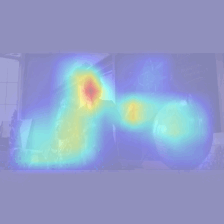Hi, I'm Minkyu. I am currently a Ph.D. student in ECE at the Univerisity of Michigan. I specialize in machine learning and computational neuroscience. My research aims to enhance machine intelligence, particularly in vision and language understanding, to mirror human efficiency and intelligence.
My detailed research areas include,
- Efficient and robust computer vision systems
- Integrated learning of multimodal language and vision
- Learning models for multimodal brain and body signals (application to healthcare)
- Advanced eye-tracking and brain signal prediction methods (application to AR/VR)
[Example of my research] Do machines see the world in a way that we do?
Figure 1. What if machine vision has virtual eyes, and move its eyes in a similar way humans do? Check my recent paper at NeurIPS-23. Highlighted areas represent regions where the machine focuses its attention, simulating human eye movements.
- [New Publication, Jan. 2024] My new paper is accepted at Neural Computation, and will be out soon. In this study, I try to answer the source of robustness of human visions as opposed to computer vision, which is still vulnerable to malicious attacks.
- [New Publication, Sept. 2023] My recent publication at NeurIPS-23 focuses on predicting human eye movements and brain encoding, with possible applications in AR/VR for neural interface control.
- My full publication list can be found at Google Scholar.
- I am currently working on predicting human emotions based on the brain and body signals, which can be applied to mobile fitness trackers.
- I interned as Machine learning research engineer (Summer '22) at Samsung Research America. I worked on building motion synthesis deep generative models for virtual avatar.
I've always been fascinated by the intricate workings of the human brain and the potential of machine learning to mimic and enhance human cognitive processes. My passion for this field was ignited during my undergraduate studies when I first encountered the complexities of neural networks. What drives me in my research is the pursuit of understanding how we can make machines not just mimic, but also complement and expand human capabilities. I'm particularly intrigued by the intersection of neuroscience and AI, where every discovery feels like a step towards unraveling the mysteries of human intelligence. In the long term, I aspire to contribute to breakthroughs that bridge the gap between human and machine intelligence, making technology more intuitive and beneficial for society.
I'm always eager to explore new ideas, tackle challenging problems, and collaborate with like-minded individuals and teams. If my work resonates with you or if you're interested in discussing potential collaborations, please feel free to dive into my repositories, follow my updates, or reach out to me directly through LinkedIn or email. Whether you're a fellow researcher, a student, or just curious about the world of computational neuroscience and machine learning, I'm open to conversations and opportunities. Let's innovate and grow together!
Feel free to connect with me on LinkedIn or email me for collaborations and inquiries.




